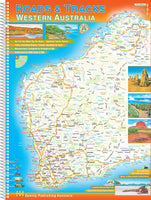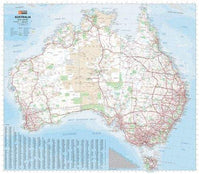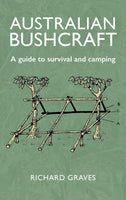Landlords of the Iron Shore gets a write-up in the Australian

 Hesperian Press' new title got a great write-up in the Australian last weekend. Read on after the break for the full article or check out the book here:
Landlords of the Iron Shore
Hesperian Press' new title got a great write-up in the Australian last weekend. Read on after the break for the full article or check out the book here:
Landlords of the Iron Shore
ITS rock underfoot has the ring of metal, its deep red ranges run straight for hundreds of kilometres, its spinifex is lemon yellow, its skies have the bleached grey blue of some sombre heaven. Yet for all its vast simplicity and its aggressive beauty, the Pilbara region remains little known in wider Australia.
The harsh stories of its settlement are quite unfamiliar, its whole past is an empty, silent void. If it comes to mind at all, it is as a quarry, a network of mine sites, traversed by unending ore trains, overflown by jets full of shift-workers shuttling from their far-off homes.
It was to this country, then still almost untouched by Western man, that John Slade Durlacher came in 1876, still in his mid-teens and under the shadows of family disgrace. His father Alfred, a magistrate at Geraldton and an early student of Aboriginal traditions, had been caught up in a financial mismanagement scandal and had hit the colonial headlines.
The son made for the remote Pilbara: he spent years on that furthest frontier, living in the company of traditional Aboriginal people as much as that of Europeans.
Settlement was in its early stages then: the land was still being explored, claimed and reshaped. There were pearling boats at the jetties of the new ports, there were vast sheep stations in the hardscrabble inland. Durlacher saw this new world, and the world that was being pulverised to build it, and set down his impressions in brief form.
Landlords of the Iron Shore is the first publication of his manuscript, which is striking for its sympathetic account of Pilbara indigenous life, beliefs and behaviour, and has no obvious parallel. He was a manager of properties and he ranged wide: he knew the tablelands above the great river systems of the northwest; he knew the Ashburton and its undulating peaks.
But he was looking for the end of the line and he came to rest on the last beachhead, West Lewis Island, part of the Dampier archipelago. The remains of old pastoral buildings can still be seen there today, close by the North West Shelf Gas Project. Durlacher writes: "The mainland opposite to our homestead, and the islands adjoining the Flying Foam Passage, namely Angel, Gidley, Dolphin, Hauy and a number of other small islands were inhabited by a mixed tribe of natives, some belonging to the country."
But the landscape round about was already being claimed and occupied, it was a chaos of concentrations and dispossessions, overlaid by the continuous movement of chancers from the frontier world: "Others had fled there out of the reach of the law, as the country is very rugged and inaccessible and the shore in parts fringed with dense mangrove thickets which made splendid hiding places for the outlaws and law-breakers from the sheep stations and settlements of Roebourne and Cossack."
Here Durlacher worked, watched, sketched and wrote. His detailed, rather childlike drawings provide a record of the material culture of the Aboriginal groups he moved among. Durlacher provides a succinct ethnographic overview - their social system, rituals, dances, songs and ceremonies - but his chief interest is in the day-to-day, life as it was lived by the indigenous family groups he knew:
So, reader, let me lead you in fancy to the great open plains of the unsettled districts. Imagine yourself lying peacefully by your camp fire, on the grassy banks of some creek or river, and for a background the wide, almost treeless plain, reaching out for miles until earth and sky seem to meet, in an almost unbroken line.
Daylight comes, the quiet gives way. Men head off for the kangaroo hunt and Durlacher's prose quickens. The men stride over the rugged hillsides "as easily and quietly as we would move on a grass lawn". They see the tell-tale traces of their prey, they close in, to windward, fire is lit in the spinifex, there are whistles, all is set. The kangaroos "are sitting bolt upright in the graceful position that these creatures assume when alarmed". The end comes fast.
Durlacher goes on turtle and dugong hunts. He is caught up in their pace and tension. It is an active, urgent world he brings to life. But that world had been placed in servitude.
When Durlacher reached the far northwest, the frontier economy there was booming: wool, pearlshell, pearls, sandalwood were all harvested and exported at high profit. Labour costs, in that initial phase of the Western intervention in the Pilbara, were next to nothing, "the despised Aboriginal black fellow" provided the wood-cutting and carting workforce; were the divers, beachcombers, boatmen, shepherds, stockmen and rough riders along the shorelines and across the sheep stations of the north.
But when Durlacher came to look back a generation on, at the century's end, that workforce had been dispensed with: the pearlbeds were bare, the sandalwood trade was played out, the "inevitable wire fence" had made station shepherding a dead trade. Durlacher had admired the "ancient laws and customs" of the people he met in the bush; now he saw a bleak prospect for the Pilbara's indigenous people: "A fast decaying race they are, diminishing rapidly in numbers, degraded by their intercourse with the white race."
He is touching here on the dramatic depopulation of the northwest, one of the least-examined questions in the story of Australian settlement - for the Pilbara has been relatively ill-served by historians. There is the majestic overview provided by Shirley Kay Forrest in The Challenge and the Chance, now almost two decades old - and little else, for a whole province.
The rivers and the gorge valleys were well peopled before the coming of the settlers, as even a casual bush trip today makes all too plain, and the early stations supported large Aboriginal communities. Disease and disruption took their toll, supplemented by their usual under-acknowledged accomplice: organised killing. In this case, the sharpest impact came from the reprisal raids known nowadays as the Flying Foam Massacre, a series of attacks carried out in the coastal country where Dampier and Karratha now stand. Durlacher was in the country eight years after this campaign and makes light of it, perhaps not quite grasping the episode's true scale: it is the sole note in his narrative that jars.
What forged this observant, open-hearted man? Ethnohistorian Peter Gifford suggests in his introduction to this book that the family tradition of engagement with indigenous affairs might have influenced the young Durlacher's decision to head north. Going to the Pilbara in 1876 would give him the opportunity of seeing an indigenous culture before its atomisation - it would give him the experiences his father had been given a generation earlier around Geraldton and Toodyay.
Hence the tone of measure and assessment in his presentation. He is not just a chronicler, he is also a voice of social conscience.
On his death in 1918 his reminiscences remained unpublished. The handwritten manuscript, it seems, passed to his daughter, Janet Drummond Nanson, a well-known Perth journalist who wrote under the bylines Sigma and Aunt Mary in The West Australian and The Western Mail. Perhaps through her, Durlacher's account eventually came into the hands of a much more prominent and determined journalist, the adventuress Ernestine Hill, a woman with pronounced ideas about prose style and a keen taste for frontier narratives.
Hill typed up a version of the manuscript, sharply re-edited. She gave the work its current, rather baroque title and an edition of some kind was planned.
"But," Gifford tells us, "as with much of Hill's later work as she became affected by ill-health and chronic money worries, the typescript was never published and lay for years in the collection of her papers held by the University of Queensland library."
This archived version led that sleuth of the outback, Hesperian Press publisher Peter Bridge, to track down the handwritten original, which had been sold to the National Library in Canberra by Hill's niece, and onsold to the Battye Library in Perth, each time for substantial sums, each time without the Durlacher family's knowledge. The detective work has at last borne fruit. Durlacher's own text has been restored for its debut in print. As Gifford explains, he deserves this courtesy: he was there, living on the frontier, change and upheaval all around him. "He had no European companions for much of his time and so he occupied himself by carefully observing and noting how his how his indigenous neighbours lived and worked for their living."
Now Durlacher's time has come. His word portraits of Aboriginal life have a marvellous freshness and sweetness. He is extensive and plunges into byways of detail: war, cuisine, bush tobacco, indigenous aesthetics and colour sense - he covers them all.
Some years ago word of the work's existence filtered out to the Pilbara: Roebourne shire was preparing its own version of Durlacher's manuscript at the same time Hesperian's project was running. The two ventures were conjoined and found support from the cultural heritage division of Rio Tinto Iron. For the mining giant now ships the ore of its great inland open-cuts from a port in the archipelago where Durlacher once lived, and where the indigenous people he knew once made their dugong and turtle hunts.
That landscape was inscribed on the Natural Heritage register six years ago, and with it the Burrup peninsula's complex of rock art sites. As a result of a conservation agreement between Rio and the commonwealth, the company funds projects that underpin indigenous culture. Landlords of the Iron Shore is one, and so a Pilbara circle closes: more than a century after its chapters were first written down, Durlacher emerges from the shadows that have cloaked him, and the men and women whose life-ways he captured stand before us. Words of witness from the colonial frontier come to life.
Landlords of the Iron Shore
By John Slade Durlacher
Introduction by Peter Gifford
Hesperian Press, 106pp, $25
Nicolas Rothwell is a senior writer on The Australian, based in Darwin.
See the original article here.
Featured collection
Categories:
australia
news
reviews
Posted on: Sep 26, 2013








Comments